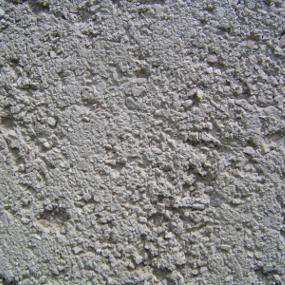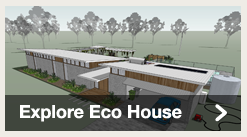Build it Back Greenbushfires
Concrete
 Concrete is an excellent
material for creating thermal mass in a passive solar designed
home. In temperate and cool climates thermal mass helps regulate a
home's temperature and keep it warm in winter and cool in
summer.
Concrete is an excellent
material for creating thermal mass in a passive solar designed
home. In temperate and cool climates thermal mass helps regulate a
home's temperature and keep it warm in winter and cool in
summer.
An exposed concrete slab floor, positioned in front of windows in a north-facing living room, receives direct sun in winter. It absorbs the solar radiation and warms the house into the night. With appropriate shading, the sun won't hit the concrete over summer, so the chill of the concrete will help the home stay cool.
Other benefits of concrete are that it can have a long life time if designed and used properly, can be used as a non-chemical termite barrier, can be easily formed into complex and adaptable shapes and designs, is fully recyclable and fire resistant.
On the downside it is a poor insulator and conventional concrete has a high environmental footprint due to the amount of energy needed to create it.
However there are some concrete products on the market which are reducing the carbon footprint of concrete.
Some concretes contain fly ash and slag (by-products of burning coal and smelting iron ore, respectively) which comfortably replace over one-fifth of the cement content - more with chemical admixtures - without adversely affecting the quality of the product.
Suppliers
Boral - www.boral.com.au/productcatalogue/product.aspx?product=2031
Ph. 02 9220 6300
Hebel - www.hebelaustralia.com.au
Ph. 1300 369 448
Independent Cement - www.independentcement.com.au
Ph. 03 9676 0000
Sadler Stone - www.sadlerstone.com
Ph. 1800 262 011
Zeostone - www.zeostone.com.au
Ph. 03 9555 6066
- More Info
- > Sanctuary magazine
- > Your Home
Listed suppliers are a guide and are not endorsed by Green Cross Australia or the Alternative Technology Association.
Latest images
flickrLatest videos

Anthony Smith, resident of Kinglake, talks about building his new Nine Star Home in the aftermath of Black Saturday.

Green Cross Australia's CEO Mara Bun admires Robyn Morris' new sustainable and fashionable home that she rebuilt following the Black Saturday bushfires.


